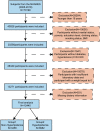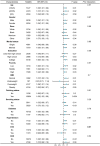A cross-sectional study exploring the relationship between the dietary inflammatory index and hyperlipidemia based on the National Health and Nutrition Examination Survey (2005-2018)
- PMID: 37653500
- PMCID: PMC10470145
- DOI: 10.1186/s12944-023-01908-x
A cross-sectional study exploring the relationship between the dietary inflammatory index and hyperlipidemia based on the National Health and Nutrition Examination Survey (2005-2018)
Erratum in
-
Correction: A cross‑sectional study exploring the relationship between the dietary inflammatory index and hyperlipidemia based on the National Health and Nutrition Examination Survey (2005-2018).Lipids Health Dis. 2023 Sep 27;22(1):161. doi: 10.1186/s12944-023-01924-x. Lipids Health Dis. 2023. PMID: 37752583 Free PMC article. No abstract available.
Abstract
Background: Hyperlipidemia is closely associated with dietary patterns and inflammation. However, the relationship between hyperlipidemia and the inflammatory potential of diets remains unexplored. The research was conducted to examine the relationship between hyperlipidemia and dietary inflammatory index (DII).
Methods: The data utilized in the research were acquired from the National Health and Nutrition Examination Survey (NHANES) from 2005 to 2018. The information on dietary intake was gathered by conducting 24-h dietary recall interviews. Restricted cubic spline (RCS) and Survey-weighted logistic regression were utilized to determine the association between DII and hyperlipidemia. Furthermore, stratification analysis was carried out.
Results: This study included 8982 individuals with and 3458 without hyperlipidemia. Participants with hyperlipidemia exhibited higher DII scores than those without hyperlipidemia. Following adjustment for gender, age, race, education level, marital status, poverty, drinking status, diabetes, hypertension, smoking status, body mass index (BMI), chronic kidney disease (CKD), cardiovascular disease (CVD), and hemoglobin (Hb), the association between the prevalence of hyperlipidemia and DII remained significant. The RCS data demonstrated that the hyperlipidemia prevalence did not exhibit an increase until the DII score was approximately 2.78. Stratification analysis revealed that the association between DII and hyperlipidemia persisted in all subgroups.
Conclusions: DII was associated with hyperlipidemia, and the threshold DII score for the risk of hyperlipidemia was 2.78.
Keywords: Diet; Dietary inflammatory index; Hyperlipidemia; Inflammation; National Health and Nutrition.
© 2023. BioMed Central Ltd., part of Springer Nature.
Conflict of interest statement
The authors declare no competing interests.
Figures



Similar articles
-
Association of Dietary Inflammatory Index with CKD progression and estimated glomerular filtration rate in the American CKD population: A cross-sectional study.PLoS One. 2024 Feb 22;19(2):e0297916. doi: 10.1371/journal.pone.0297916. eCollection 2024. PLoS One. 2024. PMID: 38386646 Free PMC article.
-
Dietary Inflammatory Index and Its Association with the Prevalence of Coronary Heart Disease among 45,306 US Adults.Nutrients. 2022 Oct 28;14(21):4553. doi: 10.3390/nu14214553. Nutrients. 2022. PMID: 36364813 Free PMC article.
-
Association between dietary inflammation index and female infertility from National Health and Nutrition Examination Survey: 2013-2018.Front Endocrinol (Lausanne). 2024 May 2;15:1309492. doi: 10.3389/fendo.2024.1309492. eCollection 2024. Front Endocrinol (Lausanne). 2024. PMID: 38757001 Free PMC article.
-
Greater Dietary Inflammatory Index score is associated with higher likelihood of chronic kidney disease.Br J Nutr. 2018 Jul;120(2):204-209. doi: 10.1017/S0007114518001071. Br J Nutr. 2018. PMID: 29947319
-
Association between dietary inflammatory index and cardiovascular-kidney-metabolic syndrome risk: a cross-sectional study.Nutr J. 2025 Apr 12;24(1):60. doi: 10.1186/s12937-025-01127-3. Nutr J. 2025. PMID: 40221720 Free PMC article.
Cited by
-
Association between composite dietary antioxidant index and hyperlipidemia in adults based on the NHANES.Sci Rep. 2025 Jan 18;15(1):2382. doi: 10.1038/s41598-025-86223-4. Sci Rep. 2025. PMID: 39827264 Free PMC article.
-
Lipid-lowering effect of combined therapy with high-intensity statins and CETP inhibitors: a Systematic Review and meta-analysis.Front Endocrinol (Lausanne). 2025 May 1;16:1512670. doi: 10.3389/fendo.2025.1512670. eCollection 2025. Front Endocrinol (Lausanne). 2025. PMID: 40375946 Free PMC article.
-
Is inflammation a missing link between relative handgrip strength with hyperlipidemia? Evidence from a large population-based study.Lipids Health Dis. 2024 May 27;23(1):159. doi: 10.1186/s12944-024-02154-5. Lipids Health Dis. 2024. PMID: 38802799 Free PMC article.
-
Ameliorative Effect of Heat-Killed Lactiplantibacillus plantarum Q1 (LPQ1) on Lipid Accumulation: Integration of Network Pharmacology with In Vitro and In Vivo Experiments.J Microbiol Biotechnol. 2025 Jul 29;35:e2503038. doi: 10.4014/jmb.2503.03038. J Microbiol Biotechnol. 2025. PMID: 40730505 Free PMC article.
-
Association between composite dietary antioxidant index and hyperlipidemia: a cross-sectional study from NHANES (2005-2020).Sci Rep. 2024 Jul 10;14(1):15935. doi: 10.1038/s41598-024-66922-0. Sci Rep. 2024. PMID: 38987566 Free PMC article.
References
-
- Estruch R, Martínez-González MA, Corella D, Basora-Gallisá J, Ruiz-Gutiérrez V, Covas MI, Fiol M, Gómez-Gracia E, López-Sabater MC, Escoda R, Pena MA, Diez-Espino J, Lahoz C, Lapetra J, Sáez G, Ros E. PREDIMED Study Investigators. Effects of dietary fibre intake on risk factors for cardiovascular disease in subjects at high risk. J Epidemiol Community Health. 2009;63(7):582–8. doi: 10.1136/jech.2008.082214. - DOI - PubMed
MeSH terms
LinkOut - more resources
Full Text Sources

